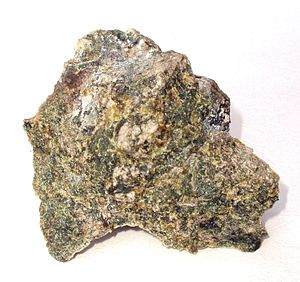Harzburgite
This article has multiple issues. Please help improve it or discuss these issues on the talk page. (Learn how and when to remove these template messages)
|
Igneous rock | |
 Harzburgite from a small intrusion 35 km south of Ambositra, Madagascar | |
| Composition | |
|---|---|
| Mostly olivine and low-calcium (CA) pyroxene |
Harzburgite, an
Harzburgite typically forms by the extraction of partial melts from the more pyroxene-rich peridotite called lherzolite. The molten magma extracted from harzburgite may then erupt on the surface as basalt. If partial melting of the harzburgite continues, all of the pyroxene may be extracted from it to form magma, leaving behind the pyroxene-poor peridotite called dunite. Harzburgite may also form by the accumulation of olivine and low-Ca pyroxene in large magma chambers of basalt deep in continental crust (layered intrusions).
Occurrence
Harzburgite is the most commonly found variety of peridotite in
Harzburgite may also be found in some
Garnet-bearing harzburgite is found as xenoliths in some kimberlite pipes, which are found almost exclusively in ancient continental cratons of Archean or Paleoproterozoic age. The mantle lithosphere under these cratons is particularly thick (up to 200 km or more) and cool. Garnet harzburgites are less depleted in the basalt component than most ophiolite harzburgites. Garnet harzburgite xenoliths from kimberlites in South Africa have been particularly well-characterized.
References
- Blatt, Harvey and Robert J. Tracy, 1996, Petrology: Igneous, Sedimentary and Metamorphic, 2nd ed., Freeman, ISBN 0-7167-2438-3
